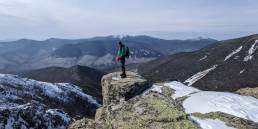At over 23 miles and with more than 9,000 feet of elevation gain, a one-day Presidential Range Traverse is no small feat. To get the best visibility, those attempting it often schedule their journey close to the summer solstice to maximize available daylight. Generally, experienced, fit hikers can complete the Traverse in 12 to 14 hours, while it can take about 18 to 20 for those less fit.
The route is most often traveled from north to south to get the majority of elevation gains over early. There are a few approaches, but most hikers choose either Valley Way or Airline. After Mt. Madison, the Gulfside trail is followed most of the way south, with diversions over individual peaks. Once Washington is achieved, the Crawford Path, the oldest-used footpath in the U.S., brings you through the Southern Presidentials, with spur trails allowing you to tag the actual summits.
-
Mt. Madison – 5367 feet
-
Mt. Adams – 5774 feet
-
Mt. Jefferson – 5712 feet
-
Mt. Clay – 5533 feet
-
Mt. Washington – 6288 feet
-
Mt. Monroe – 5384 feet
-
Mt. Franklin – 5001 feet
-
Mt. Eisenhower – 4780 feet
-
Mt. Pierce – 4310 feet
-
Mt. Jackson – 4052 feet
It should be noted those who have already bagged these peaks on other trips may opt to bypass them on a traverse, saving significant time and effort, while others may argue this was not a “true” traverse.
The Saturday before or the Saturday after the solstice is probably the most popular time to get through this trek. If you work Monday to Friday, you are really going to want all day Sunday to recover!
During this timeframe, intrepid hikers have almost 16 hours of useable daylight. Daylight, however, is not really the main issue, as a quality headlamp can make night hiking quite enjoyable. Instead, full-moon traverses are still possible when the weather is stable, so with any above-treeline White Mountain adventure, it really comes down to this factor.
![[Credit: Ryan Wichelns]](https://goeast.ems.com/wp-content/uploads/2016/06/9507268753_67287e0c8a_k-1024x768.jpg)
Tip #1: Be flexible
It would be wise to keep checking the Higher Summits Forecast every Thursday if you are thinking, “This Saturday might be the day!” Because of this aspect, don’t lock into the Saturday before or after the solstice. Rather, give yourself two weekends as potential green-light dates. As you do, pay close attention to the weather. Low pressure coming in with freezing rain and high winds? Not this weekend. High pressure cresting on Saturday with a stable-looking Sunday? Let’s go for it!
Tip #2: Carry the right gear
If you’ve been planning this trip, you probably know a good amount about the gear you should take hiking. But for this journey specifically, aim for a total pack weight no greater than 15 lbs., including 100 oz. of water in a hydration bladder. While you shouldn’t skimp on proper clothing and food, realize the goal is to keep moving, so a light pack will really help here. As well, trekking poles should not be sacrificed to save weight; instead, use them for ascent and descent.
Tip #3: Plan for the best, and prepare for the worst
Mountain weather is fickle, and physical fitness sometimes eludes us. While this traverse is committing, it is not without escape routes, so find them in advance. Study the map to know which trail offers the best getaway below tree-line from each section of the route – hopefully, on the same side as your vehicle.
Also, consider carrying a PLB (Personal Locator Beacon), but realize the very important fact that outside help can often be 12 or more hours away! So, for these extreme cases, be self sufficient and know how to self-rescue!
Tip #4: Bailing is not failing
Success in the mountains is not judged by the summits reached or miles covered. Instead, it is judged by whether you had fun with your friends and made it home safe – that is the most important part of any mountain adventure. If the weather turns, or if a companion isn’t feeling great, do the right thing and shorten the trip – it’s okay. The range has been there for thousands of years, and it will be there for thousands more, so you can alway come back next year to try again!
David Lottmann
David is a self proclaimed snow & wilderness navigation geek and teaches all aspects of climbing and avalanche safety for Eastern Mountain Sports Schools in North Conway, NH along with seasonal work with our Customer Service Team. He's been with EMS since 1994 and actively blogs at www.NEAlpineStart.com
Related Posts
April 12, 2024
Explore Like a Local: The Outdoor Mecca of North Conway, NH
There's a lot to love about this New…
April 3, 2024
5 Things To Do in the Boston Area During Mud Season
Adventure opportunities are abundant…
1 Comment
Comments are closed.





I love the safety tips! Happy hiking!